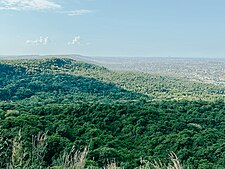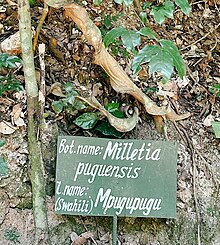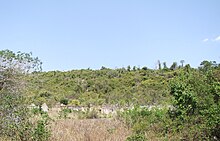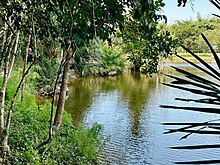Pugu Hills Forest Reserve
| Pugu Hills Forest Reserve | |
|---|---|
IUCN categoryIV (habitat/species management area) | |
 Pugu Forest Reserve panorama | |
| Location | Kisarawe DistrictofPwani Region, |
| Nearest city | Kisarawe&Dar es Salaam |
| Coordinates | 6°53′20.4″S39°5′20.4″E/ 6.889000°S 39.089000°E |
| Area | 120.1 km2(46.4 sq mi) |
| Designation | Nature Forest Reserve |
| Established | 2006 |
| Named for | Mpugupugutree inZaramo[1] |
| Governing body | Tanzania Forest Service Agency (TFS) under theMinistry of Natural Resources and Tourism |
| Website | Official Page |
ThePugu Hills Forest Reserve,officially listed asPugu/Kazimzumbwi Nature Forest Reserve(Msitu wa Akiba wa Pugu,InSwahili) is aprotected arealocated inKisaraweward ofKisarawe DistrictinPwani Region,Tanzania.The forest borders in thePuguward, ofIlala MCinDar es Salaamto the east, adjacent to theKazimzumbwi Forest Reserve.Together with Kazimzumbwi, the Pugu Forest (previously known asMogo Forest) is part of what is considered to be one of the oldest forests in the world. The area is characterized by a large variety ofendemicspeciesofanimalsandplants.[2][3][4]

Geography
[edit]
The 22 km2reserve extends over a large hilly area south-west of Dar es Salaam, the nearest populated place beingKisarawe.[5]The source of theMsimbaziriver, that flows into theIndian Oceanin the surroundings of Dar, is inside the reserve. A large fraction of its vegetation is composed ofevergreenplants, asrainis common and abundant throughout most of the year. One of the largestkaolinitedeposits in the world is located inside the reserve.
Fauna and flora
[edit]
The Pugu Forest has 14 endemic plantspecies,twomammalianendemic species, and one endemic subspecies ofbirds.Wildlife include,Dikdiks,common warthogs,African leopards,elephant shrews,mongooses,civets,galagos,side-striped jackals,black-backed jackals,baboons,alligators,colobuses,as well as over 80 species of birds.Lionsused to live in the reserve, but none has been reported in recent times. Some natural and human-madecaveshost large colonies ofbats,such ashorseshoe bat,Tanzanian woolly batandHildegarde's tomb bat.[6][7]
Attractions
[edit]There are also enormous bamboo stands, the lake Minaki, bat caves, overlooks of Dar es Salaam City, places of worship, sacred ritual sites, the unique Mpugupugu tree (from which the reserve derives its name).[8][9]

References
[edit]- ^Kapingu, M. C., et al. "A novel isoflavonoid from Millettia puguensis." Planta Medica 73.09 (2007): P_085.
- ^"Pugu Forest Reserve".protectedplanet.net.
- ^Kapingu, Modest C., et al. "Puguflavanones A and B; Prenylated flavanones from Baphia puguensis." Natural Product Communications 3.5 (2008): 1934578X0800300514.
- ^Howell, K. M. "Pugu Forest Reserve: biological values and development." African journal of Ecology 19.1‐2 (1981): 73-81.
- ^Howell, K. M. (1981)."Pugu Forest Reserve: biological values and development".African Journal of Ecology.19(1–2): 73–81.doi:10.1111/j.1365-2028.1981.tb00653.x.ISSN1365-2028.
- ^Tanzania Forest Service Agency (2023)."Pugu Forest Reserve".TFS.
- ^Johnson, David M., Leonard B. Mwasumbi, and Frank M. Mbago. "New species of Xylopia and Uvaria (Annonaceae) from Tanzania." Novon (1999): 55-60.
- ^Kapingu, M. C., et al. "A novel isoflavonoid from Millettia puguensis." Planta Medica 73.09 (2007): P_085.
- ^Tanzania Forest Service Agency (2023)."Pugu Forest Reserve".TFS.

